The last time I visited the Dodecanese, I didn’t have a polaroid camera with me. However, the idea of starting the Polaroid Diaries section on my travel blog was born around the time I last visited the Twelve Islands. It was in July 2019, during my visit to beautiful Astypalaia, that I thought of presenting my travel polaroids. Therefore, it sounded fair to pack an instant camera in my backpack on the occasion of my return to that marvelous Greek island complex.
Located in the southeastern part of the Aegean Sea -and probably the country’s sunniest corner- the Dodecanese is a cluster of islands. It consists of twelve bigger and dozens of smaller islands. Some of them, like Rhodos or Patmos, are famous worldwide. However, as it’s often the case, beauty lies off the beaten path. For this journey to this side of Greece, I decided to visit three islands -and that’s how one more entry of the Polaroid Diaries came to life.
Specifically, the idea was to visit three islands: Kos, the island of Hippocrates, Nisyros, the volcanic island, and Tilos, the place where the last elephants in Europe lived. I have never been to any of these islands, but I knew I wanted to shoot polaroids. Knowing it would be sunny in the Dodecanese, it was easy to decide on the best instant camera for my journey: I packed the Polaroid SX-70.
I had one film with me, and I knew I had to make the most of it.
*Some of the links are affiliate links. It means that if you buy something, I might earn a small commission at no additional cost to you.
What’s on the Polaroid Diaries: Dodecanese (SX-70)
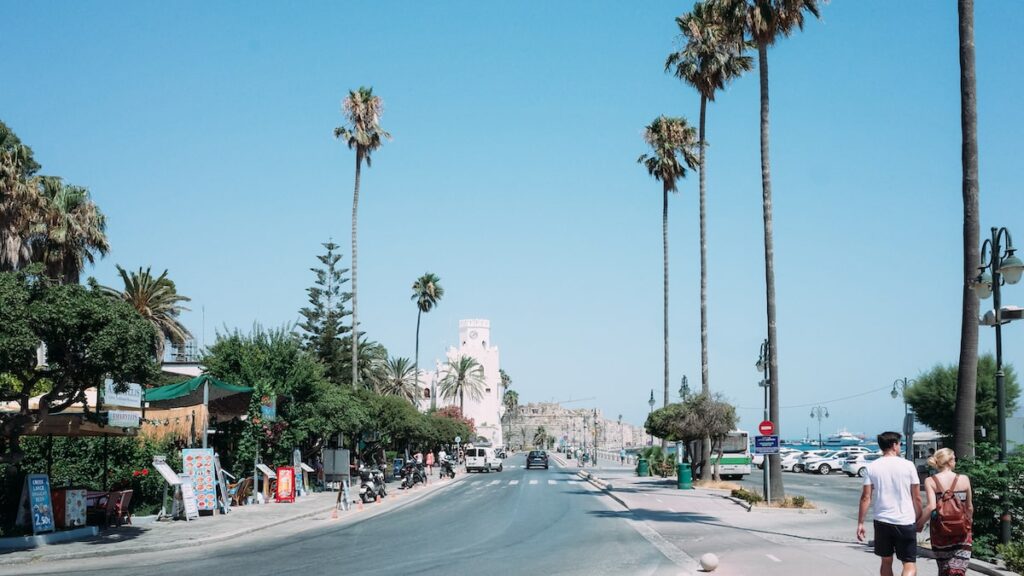
In this edition of the Polaroid Diaries, you will see the eight photos I shot with the SX-70 in three of the Dodecanese islands. The light was harsh while visiting the islands, and I found it challenging to shoot good photos. In fact, most of the time, I felt insecure because I thought the images would look washed off due to the heat. Of course, if you follow my instant photography editions, you know that I always regret not having more films with me. Apparently, the same happened this time.
So, apart from the SX-70 polaroids, you will also read some info about where each photo was shot. Moreover, at the bottom of this post, you’ll find -like always- the settings I used for shooting the images. Although I didn’t experiment that much due to extreme weather conditions, I believe getting more info is useful, especially when you see images you like.
So, let’s start now with the polaroids from Nisyros, Tilos, and Kos, taken with the legendary SX-70.
Polaroid Diaries: Dodecanese (Polaroid SX 70)
Whenever possible (in other words: affordable), I try to stay at hotels with a sea view. The day I arrived in Kos, I first opened the balcony door and enjoyed the view. Kos, the place where the father of medicine, Hippocrates, was born, enjoys hundreds of days of sunshine. My room was facing the palm trees and the waterfront promenade.
Although I often talk about how polaroid photography makes us thoughtful, I didn’t think twice this time: I shot straight a photo. And here’s my view from Orpheus Studios in Kos.
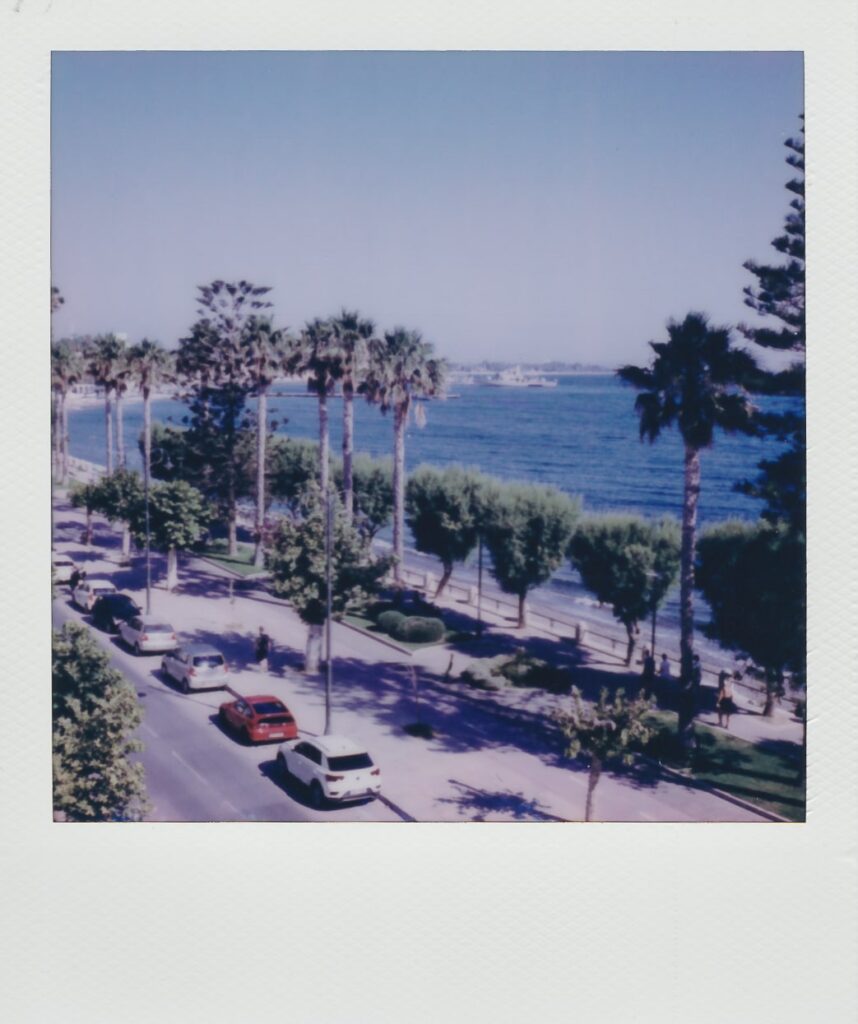
Since I was more interested in seeing Nisyros and Tilos, my stay in Kos was short this time. However, I managed to see a few things and visit some places. One of the most photogenic locations in Kos is, hands down, the Neratzia Castle. Located next to the port in Kos Town, the castle dates back to the 14th century. It was built by the Knights of the Order of St John -also mentioned in my Malta polaroids– and its name derives from the bitter oranges (Greek: Νερατζιές) planted on the island this era.
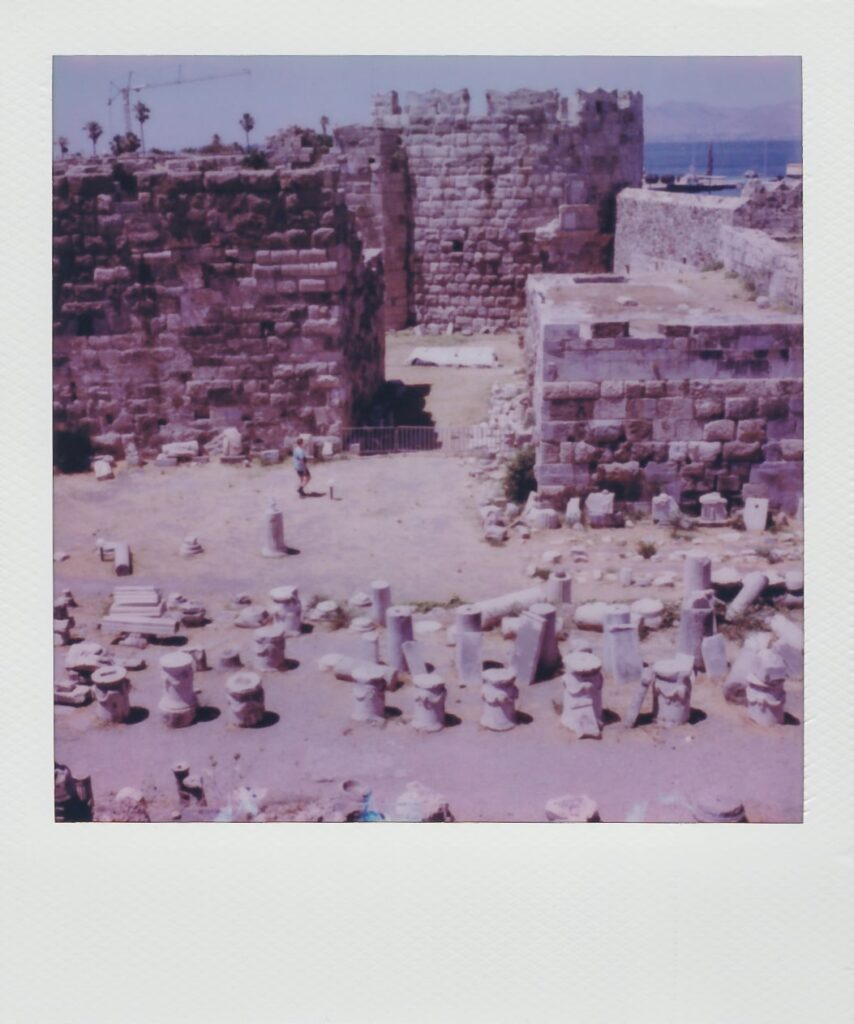
Of course, if you’ve been following my instant photography diaries -or even better, if you purchased my polaroid zines– you know I love shooting polaroids of flowers. So, although I had already shot two photos and I had just six more for the entire journey, I decided -once again…- to be less thoughtful and shoot another polaroid. I couldn’t resist shooting these red lilies I came across while strolling around Kos.
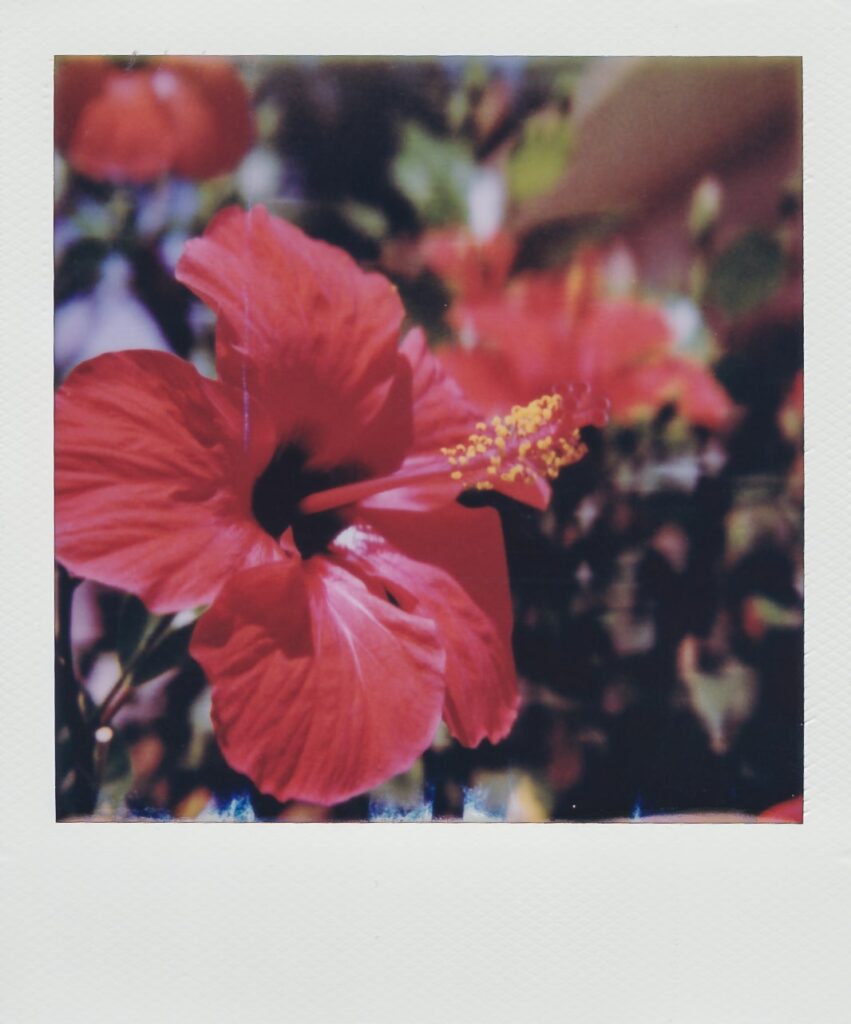
So, after leaving Kos, I knew I had to be more careful while shooting. Otherwise, I wouldn’t have enough photos for the rest of the journey. Buying polaroid films on a Greek island is impossible, so I decided to take it easier when I arrived in Nisyros. It wasn’t easy. Nisyros is a stunning island featuring an active volcano. You can walk on its crater -its name is Stefanos- and shooting photos is a must. Obviously, I couldn’t leave Nisyros without shooting with the SX-70 on the volcano’s crater. So, here’s a volcanic polaroid.

Thoughtfulness wasn’t a thing on this journey. A few seconds after shooting the image you saw above, I thought of taking a polaroid of Barbara. We traveled together to the Dodecanese, and I thought human presence might contribute more to the volcano’s scale. Hence, here’s a photo of Barbara in the volcano.

As you probably noticed, both polaroids from the volcano have a warm tint. That’s due to the high temperature in the volcano’s crater. Polaroids couldn’t develop optimally, and the extreme heat always produces this yellow tint on images. That said, I decided that the next time I’d shoot a polaroid in Nisyros would be before sunset. The temperature will be lower, and the sun not intense anymore. I climbed to the monastery of Panagia Spiliani and took a photo of Mandraki, the main settlement of Nisyros. And here’s how beautiful Mandraki is.
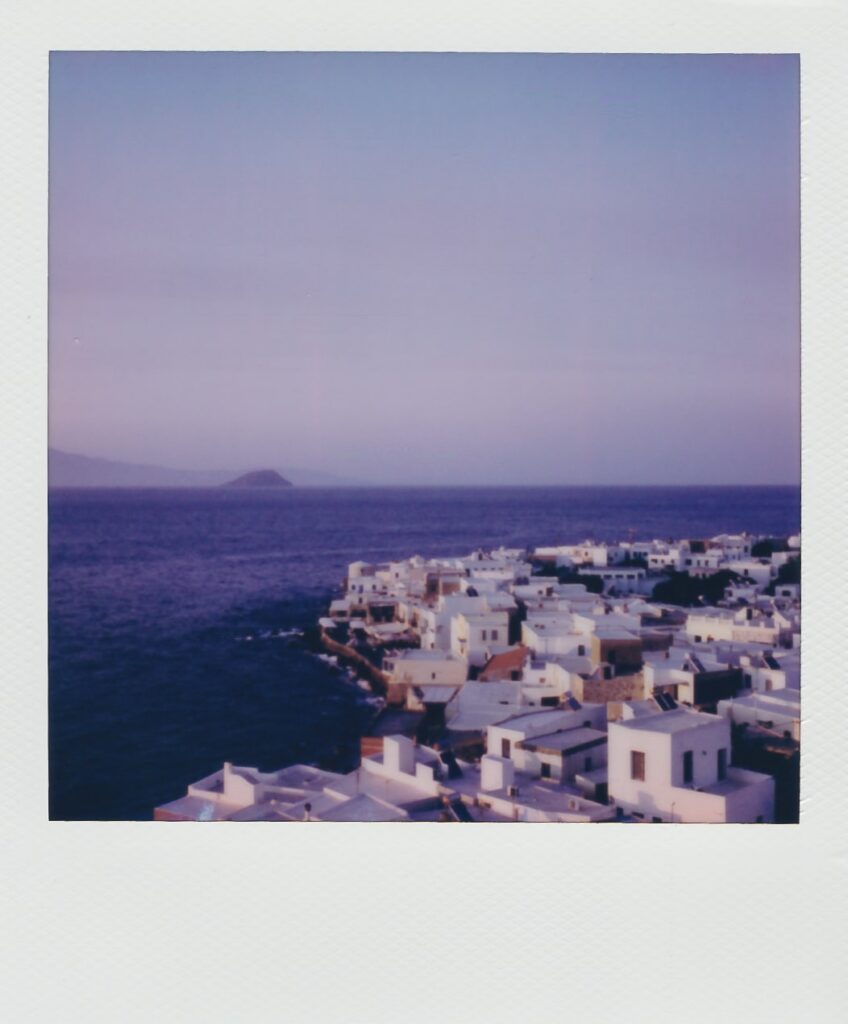
With just two polaroids left on the film roll, I traveled to Tilos for the final part of the journey. Compared to Nisyros, Tilos is a tranquil island. However, Tilos has its moments and some great locations to explore. The first one is the Mikro Chorio or Small Village. It’s an abandoned village with an eerie touch. No one lives there anymore; however, there’s a bar that opens during the summertime for a few hours every night. It deserved a polaroid, and here’s how Mikro Chorio in Tilos looks:

Finally, the last photo of this polaroid diary has a more dramatic touch. One of the most distant Tilos settlements is Agios Antonios. It’s a small fishing village where just a handful of people live. The landscape is magnificent, and the village is exposed to the winds. I reached the village’s edge and shot the film’s last polaroid.
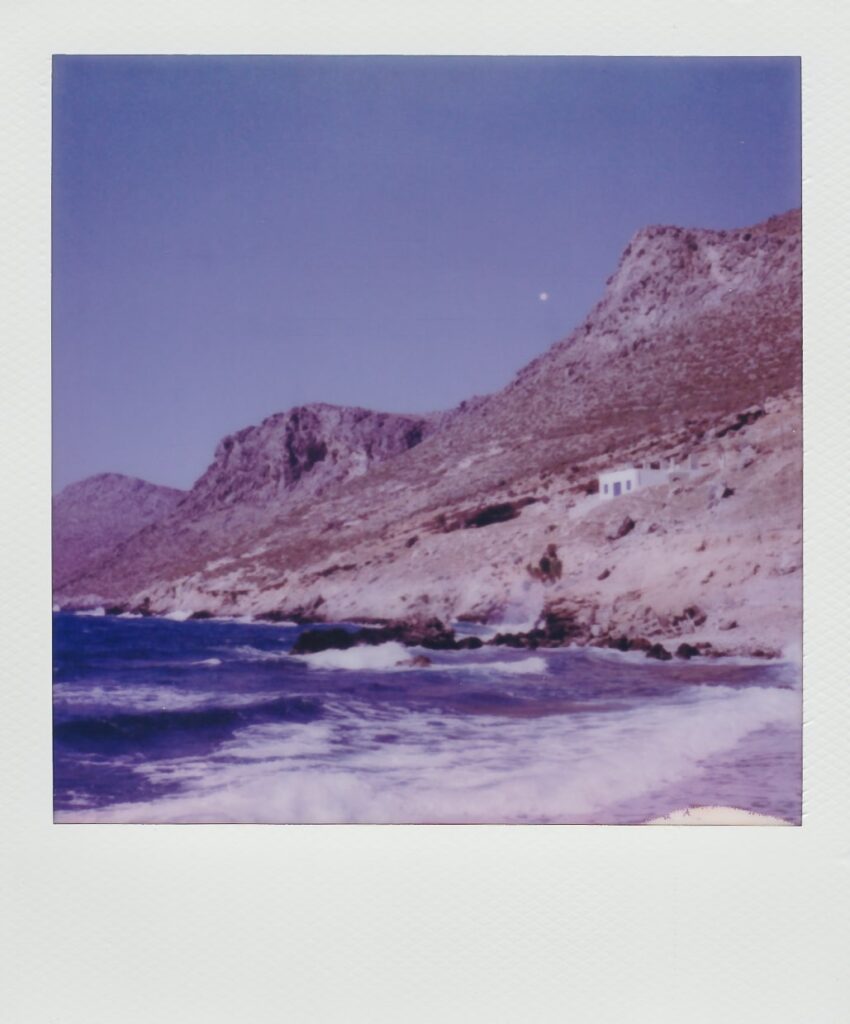
My Polaroid SX-70 settings for this diary
Due to the intense light of the three islands, I decided to underexpose every photo I took. It didn’t matter if the sun was in front or behind me: I knew that I had to move the exposure wheel toward darkness slightly in order not to have washed off colors. Given the heat, I believe it was the right thing to do because even the volcano photos look good.
The photo I questioned myself the most about the settings is the one showing the red lilies. Initially, I considered keeping the exposure wheel in the middle because the light seemed less optimal. However, I decided to take the same approach since I thought of underexposing every image. Most likely, I would have gotten a good result if I had kept the wheel in the middle. But I don’t regret it, because I think the image looks good.
Finally, here’s the usual note I add at the end of each post. Apart from adding a +20 in sharpness for web optimization, the Dodecanese polaroids you saw above have no touches in post-processing. While I find it important to optimize every image for the web, adding contrast, colors, etc., I believe it’s lame when it comes to polaroids. Therefore, the Dodecanese polaroids above look exactly like those in my drawer.
And that’s it with the 23rd edition of the Polaroid Diaries with images from Nisyros, Tilos, and Kos, in Dodecanese, Greece, with the SX 70. Don’t forget to subscribe to the mailing list below if you want to see more polaroids, camera reviews, and tips. And check out my Polaroid Zines, which are an excellent gift for photography lovers.
*You can buy the newest (and freshest) films and Polaroid cameras directly at Polaroid’s official websites.*
The US Store | The EU store | The UK Store
**If there’s no availability in the official stores, search for second-hand SX 70 cameras on Amazon.
More Polaroids: The complete Polaroid diaries
Polaroid Camera reviews: My Now+ review, Polaroid Sun 660 review & Polaroid OneStep+ review
Pin it for later

Sharing is caring. Share the Polaroids from Dodecanese, Greece, with your friends.
Last Updated on February 25, 2023 by George Pavlopoulos

